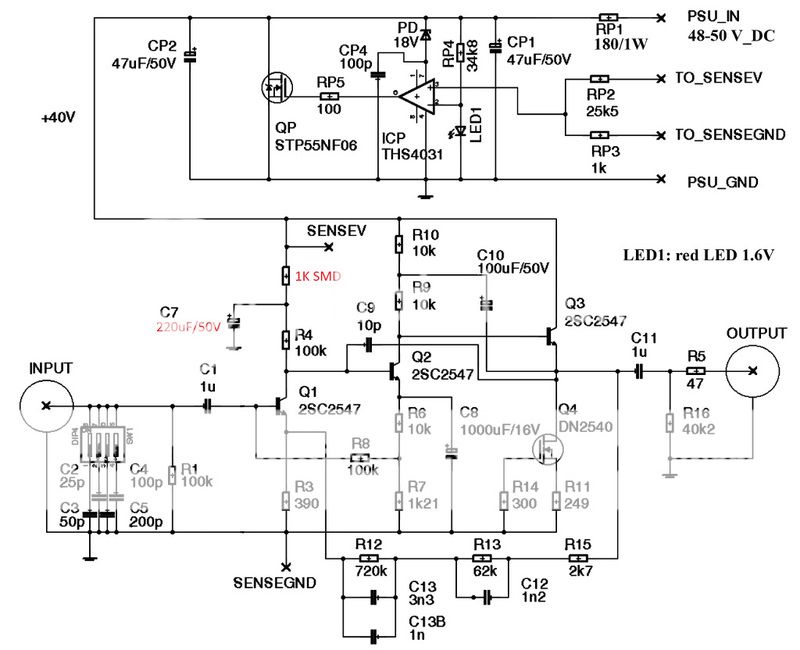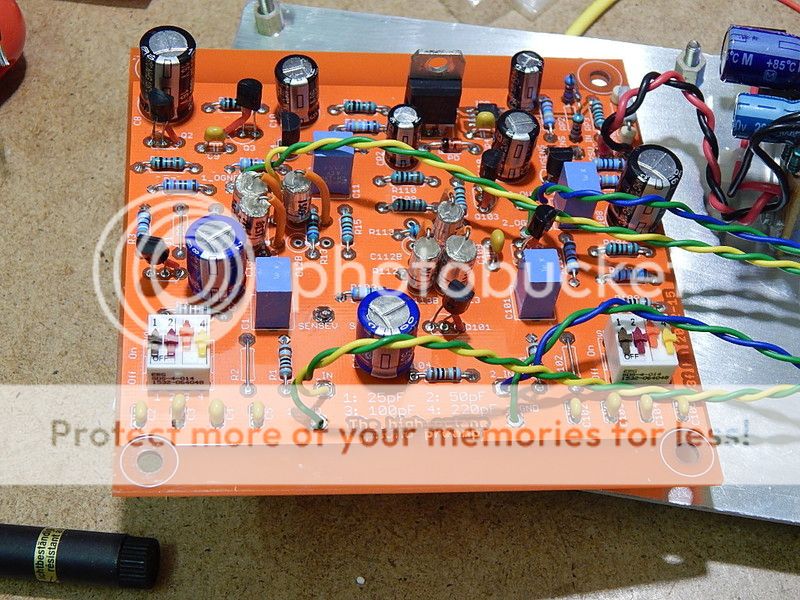Interesting! This makes a lot of sense to me. I have not simulated this circuit, but on occasion, playing/simulationg some projects, I noticed that in some cases indeed the supply ripple was increased by the action of some circuit stage (real "inverted" PSRR).No reg, shunt or otherwise has infinite rejection at any frequency. Then it'll generate some noise. At present with the circuit as it stands the supply line noise is being amplified almost 20dB at the output at the lowest freqs.
Since Sharif has posted the .asc on his blog, I quickly checked the PSRR. Rather a disaster at LF - injection via R2 is doing the damage. Its easy to fix up though - 100R and 470uF (RC filtering of the supply to R2) gives >20dB better PSRR @ 40Hz. I would hope this small tweak would fix up your apparent bass lightness. If not then swapping the output device polarity would be worth trying.
Like this ? Or just before R2 (100k)?
An externally hosted image should be here but it was not working when we last tested it.
Just before R2 - hence move the RC one block to the left. The action of the bootstrap capacitor there (C3) increases the PSRR for the subsequent stage.
Not quite corrected - the power supply needs to go directly to Q3's collector. As does 'SENSEV'.
I haven't looked at the physical constraints but if a 470uF cap is too large we could scale up the 100R and move the cap down in value to suit the available space.
I haven't looked at the physical constraints but if a 470uF cap is too large we could scale up the 100R and move the cap down in value to suit the available space.
Last edited:
Oh sorry, you are right! On asc file the power source is on the right side 🙂
An externally hosted image should be here but it was not working when we last tested it.
I'm at work now but looking on the pcb picture i think found a solution.
Replace C7 47uf with 470uf and cut the pcb as marked ant install a 100R resistor.
I will test this next days.
Replace C7 47uf with 470uf and cut the pcb as marked ant install a 100R resistor.
I will test this next days.
An externally hosted image should be here but it was not working when we last tested it.
Last edited:
I'm most interested if DIYBras tries this out and see if the reported lightness in the bass disappears.
Installed the 100r resistors and 470uf caps. The sound is the same, same nice trebles and sweet voices but weak, dry bass
Waiting for DIYBras feedback.
Sent from my iPad using Tapatalk
Waiting for DIYBras feedback.
Sent from my iPad using Tapatalk
Last edited:
Try upping the 100R to 1k and see if the result is the same? Btw you don't have the 'SENSEV' as shown in your modded schematic do you?
I just been looking at the schematic and notice CP2,C7 & C107 are all in parallel this may be an oversight.
All the circuit I've seen using this type of circuit have a RC before the collector resistor for PSRR.
Abraxalito I've cut the track between the SENSEV and C7,R4, same on the other channel C107,R104 and fitted 1K SMD resistors. I've also replaced C7 & C107 with 220uF caps.
I will let you know my findings.
Sharif.
All the circuit I've seen using this type of circuit have a RC before the collector resistor for PSRR.
Abraxalito I've cut the track between the SENSEV and C7,R4, same on the other channel C107,R104 and fitted 1K SMD resistors. I've also replaced C7 & C107 with 220uF caps.
I will let you know my findings.
Sharif.
Corrected.

I think it should look like this below.
I've used components I had at hand the 1K SMD resitors fits nicely when the tracks are cut between SENSEV & R4,C7 - R104,C107.

220uF cap replaces 47uF.

1K SMD resistor added between tracks.

Sharif.
Last edited:
Yes Sharif, i did the same in my circuit but only with 100R. Today if i have some spare time i will move to 1K resistor.
What are your findings regarding sound, bass especially ?
For my bass looks the same maybe the mids are a bit nicer (with 100R)
What are your findings regarding sound, bass especially ?
For my bass looks the same maybe the mids are a bit nicer (with 100R)
As others have pointed out, the main downside to this circuit is the PSRR, or rather lack of it. The amplifier itself does not reject power supply noise and ripple so much as amplify it.
Even after the adding an RC filter feeding Q1, you are still relying on the voltage regulator to do the heavy lifting. Look at what you have there - 120 dB or more feedback, a high transconductance MOSFET in that feedback loop, tasked with trying to control the voltage on a 47 uF electrolytic capacitor down to nanovolt levels - what could possibly go wrong? 😛
Anyhow, the amp circuit itself looks good - but you might want to re-think the power supply. Unwind it a little and you might get more natural bass.
Even after the adding an RC filter feeding Q1, you are still relying on the voltage regulator to do the heavy lifting. Look at what you have there - 120 dB or more feedback, a high transconductance MOSFET in that feedback loop, tasked with trying to control the voltage on a 47 uF electrolytic capacitor down to nanovolt levels - what could possibly go wrong? 😛
Anyhow, the amp circuit itself looks good - but you might want to re-think the power supply. Unwind it a little and you might get more natural bass.
Last edited:
I've had a quick listen to it against three preamps:
Naim 82 with MM boards fitted.
Linn Intek MM Settings.
Bottlehead Valve Preamp.
All feed into the tape input of the Linn Intek.
I terms of sound the High Octane preamp better all of the above being more neutral.
I think there is a marked increase in the clarity of the bass with the PSRR mod.
Against the Naim the High Octane preamp was more natural sounding and more detailed with better micro dynamic and a well defined bass that was better than the Naim.
I find the Naim tries too sound to fast and has a lumpy bass around 100-250Hz.
Against the Linn Intek (was my reference) the High Octane preamp bass was more detailed with better micro dynamics and detail, it sounded more open.
The bass on the Intek was also drier and there seem to be a shut in feeling.
Against the Bottlehead Valve Preamp mid range sound's was very similar, the High Octane preamp won in the treble and bass area with greater insight into the sound.
The bass on the Bottle head was very warm sounding and treble was recessed.
For me this little preamp is a very good sounding unit.
I have made some further mod to the preamp:-
Q1,Q101 change to selected and matched BC337-40 transistor with a Hfe 430.
The BC337-40 seems to be better as the first transistor (Q1-Q101) noise seems to be lower when listening compared to the BC550 transistors.
R12.R112 change to 700K.
R16,R115 (2K7) parallel with 1K2
When I first tried the High Octane preamp in my system the bass did not sound right, it seemed muffled and was lacking in detail and insight the PSRR mod seems to have corrected this.
(Turntable is a Phonosophie No3 with TP90 tonerm fitted with a Philips GP390 low output ceramic cartridge)
Sharif.
Naim 82 with MM boards fitted.
Linn Intek MM Settings.
Bottlehead Valve Preamp.
All feed into the tape input of the Linn Intek.
I terms of sound the High Octane preamp better all of the above being more neutral.
I think there is a marked increase in the clarity of the bass with the PSRR mod.
Against the Naim the High Octane preamp was more natural sounding and more detailed with better micro dynamic and a well defined bass that was better than the Naim.
I find the Naim tries too sound to fast and has a lumpy bass around 100-250Hz.
Against the Linn Intek (was my reference) the High Octane preamp bass was more detailed with better micro dynamics and detail, it sounded more open.
The bass on the Intek was also drier and there seem to be a shut in feeling.
Against the Bottlehead Valve Preamp mid range sound's was very similar, the High Octane preamp won in the treble and bass area with greater insight into the sound.
The bass on the Bottle head was very warm sounding and treble was recessed.
For me this little preamp is a very good sounding unit.
I have made some further mod to the preamp:-
Q1,Q101 change to selected and matched BC337-40 transistor with a Hfe 430.
The BC337-40 seems to be better as the first transistor (Q1-Q101) noise seems to be lower when listening compared to the BC550 transistors.
R12.R112 change to 700K.
R16,R115 (2K7) parallel with 1K2
When I first tried the High Octane preamp in my system the bass did not sound right, it seemed muffled and was lacking in detail and insight the PSRR mod seems to have corrected this.
(Turntable is a Phonosophie No3 with TP90 tonerm fitted with a Philips GP390 low output ceramic cartridge)
Sharif.
R16,R115 (2K7) parallel with 1K2
I made an error!
Should be R15,R115 (2K7) parallel with 1K2
Sharif.
An externally hosted image should be here but it was not working when we last tested it.
On the right shows the sim eq network for the original High Octane Riaa Preamp.
On the left it shows a modified sim eq network.
The BC550 and the BC337 did not change the response.
R8 was 720K now 700K
R10 was 2K7 now 820R
I've not tried measuring the response of my built preamp.
Sharif.
The link of picture has died meantime. Can you attach it again ?
Thanks,
Adrian
As others have pointed out, the main downside to this circuit is the PSRR, or rather lack of it. The amplifier itself does not reject power supply noise and ripple so much as amplify it.
Even after the adding an RC filter feeding Q1, you are still relying on the voltage regulator to do the heavy lifting. Look at what you have there - 120 dB or more feedback, a high transconductance MOSFET in that feedback loop, tasked with trying to control the voltage on a 47 uF electrolytic capacitor down to nanovolt levels - what could possibly go wrong? 😛
Anyhow, the amp circuit itself looks good - but you might want to re-think the power supply. Unwind it a little and you might get more natural bass.
If nothing else, making the regulator setup dual-mono should help a bit. I took a quick look at my board & believe that could be done with an off-board pair of regs and some judicious trace-cutting / linking.
That along with adding a CCS in front of each of the regs were one my plans for my build.
Greg in Mississippi
- Home
- Source & Line
- Analogue Source
- The high octane phono preamp